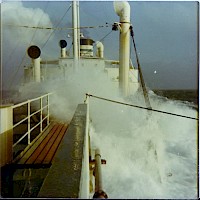
Seafaring
The ability to sail and navigate the seas has always been important to people living by the coast. In a historic perspective, most transports have been made by water. The sea, it is said, has joined people together rather than set them apart.
The seaman on the quayThe merchants of the Ostrobothnian cities owned ships which would sail to distant harbours, unload their cargos, and take new merchandise onboard. Large quantities of tar, wood products, salted herring and train oil from seals were exported from Ostrobothnia. On their journey back home, the ships would carry, for instance, salt, coffee and cotton cloth – products which would find buyers in Ostrobothnia.
The farmers had boats to take their products to the market in the nearest town. Sometimes the farmers came together to build a larger vessel, which would take the merchandise to cities further away, in the hope of a better price.
For long periods of time the Ostrobothnian ships were prohibited from taking their cargos any further than Turku and Stockholm. This centralization of foreign trade, with only a few staple cities allowed to engage in foreign trade, limited the trade routes of the Ostrobothnian ships to domestic harbours. When the restrictions were lifted in the 1700’s, the Ostrobothnian merchant fleet began to grow. Soon ships from Ostrobothnia would sail the oceans all around the world.
Shipping employed a large number of people. Pilots kept the ships away from the treacherous reefs, helping the vessels navigate. The lighthouse keepers kept their beacons burning to guide and warn the ships. Numerous shipyards employed skilled boat-builders and other craftsmen. Many families earned their livelihoods from producing tar and other export goods.


















